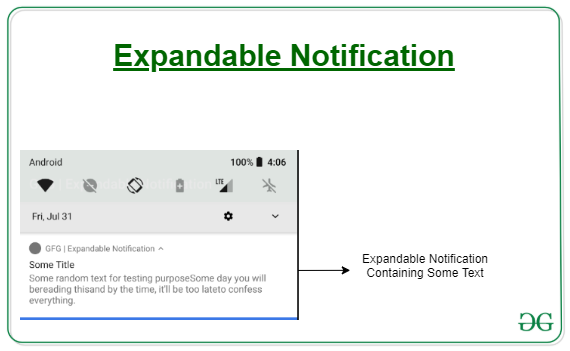Create an Expandable Notification Containing Some Text in Android
Last Updated : 04 Feb, 2025
Notification is a type of message that is generated by any application present inside the mobile phone, suggesting to check the application and this could be anything from an update (Low priority notification) to something that's not going right in the application (High priority notification). A basic notification consists of a title, a line of text, and one or more actions the user can perform in response. To provide even more information, one can also create large, expandable notifications by applying one of several notification templates as described in this article. Some daily life examples could be the notifications appended by Whatsapp, Gmail, SMS, etc in the notification drawer, where the user can expand it and can find some details about the message received such as sender name, subject and some part of the text in case of Gmail. In this article let's create a notification inside an application that contains some text.

Step By Step Implementation
Step 1: Create a New Project
To create a new project in android studio please refer to How to Create/Start a New Project in Android Studio.
Step 2: Modify activity_main.xml file
Inside the XML file just add a button, which on click would build an expandable notification. By expanding the notification from the notification drawer would display some text.
activity_main.xml:
activity_main.xml <?xml version="1.0" encoding="utf-8"?> <androidx.constraintlayout.widget.ConstraintLayout xmlns:android="http://schemas.android.com/apk/res/android" xmlns:app="http://schemas.android.com/apk/res-auto" xmlns:tools="http://schemas.android.com/tools" android:id="@+id/main" android:layout_width="match_parent" android:layout_height="match_parent" android:background="@color/white" tools:context=".MainActivity"> <!-- Button for sending notification--> <Button android:id="@+id/button" android:layout_width="wrap_content" android:layout_height="wrap_content" android:layout_marginTop="30dp" android:backgroundTint="@color/green" android:text="Send Notification" android:textSize="24sp" app:layout_constraintBottom_toBottomOf="parent" app:layout_constraintEnd_toEndOf="parent" app:layout_constraintStart_toStartOf="parent" app:layout_constraintTop_toTopOf="parent" /> </androidx.constraintlayout.widget.ConstraintLayout>
Step 3: Modify MainActivity File
Now, look at the code below which is in Kotlin. To start, build a notification with all the basic content as described in Create a Notification. Then, call setStyle() with a style object and supply information corresponding to each template, as shown below.
MainActivity File:
MainActivity.java package com.gfg.expandable_notification; import android.Manifest; import android.annotation.SuppressLint; import android.app.NotificationChannel; import android.app.NotificationManager; import android.content.Context; import android.content.pm.PackageManager; import android.graphics.Color; import android.os.Build; import android.os.Bundle; import android.view.View; import android.widget.Button; import androidx.appcompat.app.AppCompatActivity; import androidx.core.app.ActivityCompat; import androidx.core.app.NotificationCompat; import androidx.core.app.NotificationManagerCompat; public class MainActivity extends AppCompatActivity { private Button button; private static final String CHANNEL_ID = "i.apps.notifications"; private static final int NOTIFICATION_ID = 1234; private static final String CHANNEL_NAME = "Test notification"; private static final int REQUEST_CODE_POST_NOTIFICATIONS = 101; @Override protected void onCreate(Bundle savedInstanceState) { super.onCreate(savedInstanceState); setContentView(R.layout.activity_main); button = findViewById(R.id.button); // Create a notification channel (required for Android 8.0 and higher) createNotificationChannel(); button.setOnClickListener(new View.OnClickListener() { @Override public void onClick(View v) { // Request runtime permission for notifications on Android 13 and higher if (Build.VERSION.SDK_INT >= Build.VERSION_CODES.TIRAMISU) { if (ActivityCompat.checkSelfPermission( MainActivity.this, Manifest.permission.POST_NOTIFICATIONS) != PackageManager.PERMISSION_GRANTED) { ActivityCompat.requestPermissions(MainActivity.this, new String[]{Manifest.permission.POST_NOTIFICATIONS}, REQUEST_CODE_POST_NOTIFICATIONS ); return; } } sendNotification(); // Trigger the notification } }); } /** * Create a notification channel for devices running Android 8.0 or higher. * A channel groups notifications with similar behavior. */ private void createNotificationChannel() { if (Build.VERSION.SDK_INT >= Build.VERSION_CODES.O) { NotificationChannel notificationChannel = new NotificationChannel(CHANNEL_ID,CHANNEL_NAME,NotificationManager.IMPORTANCE_HIGH); // Turn on notification light notificationChannel.enableLights(true); notificationChannel.setLightColor(Color.GREEN); // Allow vibration for notifications notificationChannel.enableVibration(true); NotificationManager notificationManager = (NotificationManager) getSystemService(Context.NOTIFICATION_SERVICE); notificationManager.createNotificationChannel(notificationChannel); } } /** * Build and send a notification with a custom layout and action. */ @SuppressLint("MissingPermission") private void sendNotification() { // Build the notification NotificationCompat.Builder builder = new NotificationCompat.Builder(this, CHANNEL_ID) .setSmallIcon(R.drawable.gfg_logo) // Notification icon .setContentTitle("GeeksforGeeks") // Title displayed in the notification .setContentText("Expand to know more") // Text displayed in the notification .setAutoCancel(true) // Dismiss notification when tapped .setPriority(NotificationCompat.PRIORITY_DEFAULT) // Notification priority for better visibility .setStyle(new NotificationCompat.BigTextStyle() .bigText(getString(R.string.gfg_text))); // Display the notification NotificationManagerCompat notificationManager = NotificationManagerCompat.from(this); notificationManager.notify(NOTIFICATION_ID, builder.build()); } } package org.geeksforgeeks.demo import android.Manifest import android.annotation.SuppressLint import android.app.NotificationChannel import android.app.NotificationManager import android.content.Context import android.content.pm.PackageManager import android.graphics.Color import android.os.Build import android.os.Bundle import android.widget.Button import androidx.appcompat.app.AppCompatActivity import androidx.core.app.ActivityCompat import androidx.core.app.NotificationCompat import androidx.core.app.NotificationManagerCompat class MainActivity : AppCompatActivity() { private lateinit var button: Button override fun onCreate(savedInstanceState: Bundle?) { super.onCreate(savedInstanceState) setContentView(R.layout.activity_main) button = findViewById(R.id.button) // Create a notification channel (required for Android 8.0 and higher) createNotificationChannel() button.setOnClickListener { // Request runtime permission for notifications on Android 13 and higher if (Build.VERSION.SDK_INT >= Build.VERSION_CODES.TIRAMISU) { if (ActivityCompat.checkSelfPermission( this , Manifest.permission.POST_NOTIFICATIONS) != PackageManager.PERMISSION_GRANTED) { ActivityCompat.requestPermissions(this,arrayOf(Manifest.permission.POST_NOTIFICATIONS), 101) return@setOnClickListener } } sendNotification() // Trigger the notification } } /** * Create a notification channel for devices running Android 8.0 or higher. * A channel groups notifications with similar behavior. */ private fun createNotificationChannel() { if (Build.VERSION.SDK_INT >= Build.VERSION_CODES.O) { val notificationChannel = NotificationChannel( CHANNEL_ID, CHANNEL_NAME, NotificationManager.IMPORTANCE_HIGH ).apply { // Turn on notification light enableLights(true) lightColor = Color.GREEN // Allow vibration for notifications enableVibration(true) } val notificationManager = getSystemService(Context.NOTIFICATION_SERVICE) as NotificationManager notificationManager.createNotificationChannel(notificationChannel) } } /** * Build and send a notification with a custom layout and action. */ @SuppressLint("MissingPermission") private fun sendNotification() { // Build the notification val builder = NotificationCompat.Builder(this, CHANNEL_ID) .setSmallIcon(R.drawable.gfg_logo) // Notification icon .setContentTitle("GeeksforGeeks") // Title displayed in the notification .setContentText("Expand to know more") // Text displayed in the notification .setAutoCancel(true) // Dismiss notification when tapped .setPriority(NotificationCompat.PRIORITY_DEFAULT) // Notification priority for better visibility .setStyle( NotificationCompat.BigTextStyle() .bigText(getString(R.string.gfg_text)) ) // Display the notification with(NotificationManagerCompat.from(this)) { notify(NOTIFICATION_ID, builder.build()) } } companion object { // Unique channel ID for notifications const val CHANNEL_ID = "i.apps.notifications" // Unique identifier for the notification const val NOTIFICATION_ID = 1234 // Description for the notification channel const val CHANNEL_NAME = "Test notification" } } Note: If you have previously searched for the code for expandable notifications, then you must have seen this particular line of code:
".setStyle(NotificationCompat.BigTextStyle().bigText(message)"
As "NotificationCompat" is currently deprecated and your code would always crash whenever an attempt is made to build a notification (on button click in our case). Instead, just use "Notification".
Output: